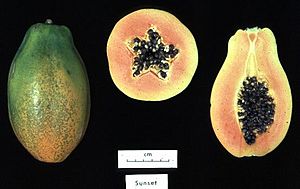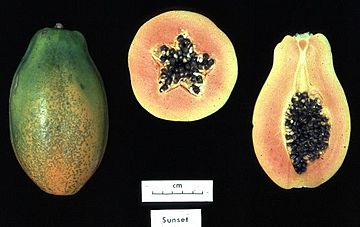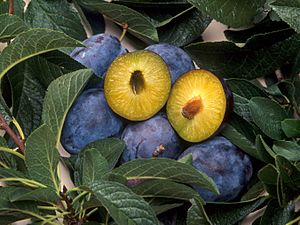Genetically modified food facts for kids
Genetically modified food (often called GM food) is food made from plants or animals that have had their DNA changed in a lab. This process is called genetic engineering. GM foods contain these changed organisms. Some common examples you might find are maize (corn), soybean, cotton, and rapeseed. The first GM food animal approved for sale was a type of salmon.
GM foods first became available for sale in 1994. A company called Calgene sold a tomato that ripened more slowly. Today, GM foods like soybean, corn, canola, rice, and cotton seed oil are common. Scientists change these crops to make them resistant to things like herbicides (weed killers), insects, or viruses. They can also add extra nutrients or make them grow faster. Scientists are also working on GM animals.
Research is also happening on bacteria that could help make cheese faster. Also, yeast that has been genetically modified might be used to make beer with fewer calories.
Contents
Rules for GM Food
Different countries have different rules for checking and allowing genetically modified organisms (GMOs). The rules in the USA and Europe are quite different.
In the USA, the rules focus on the final GM product, not how it was made. They only regulate based on real scientific risks. They also believe that GM products are similar enough to regular products that existing laws are enough to check them.
The European Union has some of the strictest GMO rules in the world. All GMOs and food treated with radiation are seen as "new food." They must go through a detailed scientific check by the European Food Safety Authority (EFSA). To be approved, GM foods must be safe, allow people to choose, be clearly labelled, and be easy to track.
However, some scientists believe that current studies are not strong enough to be completely sure that GM food is safe for everyone.
Labelling GM Food
A big question is whether GM products should have special labels. In South Africa, a study found that 31% of products labeled "GMO-free" actually had more than 1.0% GM content.
In Canada and the US, companies do not have to label GM food. But in Europe, any food (including processed food) or cattle feed that has more than 0.9% of approved GMOs must be labeled.
Countries like Japan, Malaysia, New Zealand, and Australia require labels. This helps people choose between foods that are genetically modified, regular, or organic.
GM Crops
Genetically modified crops (GM crops) are plants that have been genetically changed for use in agriculture.
The first GM crops were made for food for animals or humans. They were changed to resist certain pests, diseases, bad weather, spoilage, or chemical treatments like herbicides.
The next generation of crops aimed to make food better quality, often by changing its nutrient profile. For example, adding more vitamins.
Newer GM crops might be used for things other than food. This includes making medicines, biofuels (fuels from plants), and other useful industrial products. They can also help clean up pollution.
Most GM crops have been changed to resist specific herbicides, usually those based on glyphosate or glufosinate.
Even though some people have doubts, most studies show that growing GM crops helps farmers. They often use fewer pesticides and get bigger harvests, which means more profit.
Fruits and Vegetables
Papayas were genetically changed to resist the ringspot virus (PSRV). This helped save papaya farms in Hawaii.
In 2014, the USDA approved a genetically modified potato. This potato was changed to prevent bruising and make less acrylamide when fried. Acrylamide is a chemical that can form when some foods are cooked at high temperatures.
By 2005, about 13% of the Zucchini (a type of squash) grown in the US was genetically modified. This squash resists three different viruses. It is also grown in Canada.
In 2013, the USDA approved a GM pineapple that is pink inside. This pineapple was changed to produce more lycopene, which gives it the pink color. Its growth cycle was also changed to make it grow more evenly.
In February 2015, Arctic Apples were approved in the US. These were the first GM apples allowed for sale. They use a method called Gene silencing to stop the fruit from turning brown when cut.
Corn
Corn used for food and ethanol (a type of fuel) has been changed. It can now handle different herbicides and produce a protein from a bacteria called Bacillus thuringiensis (Bt). This protein kills certain insects. About 90% of the corn grown in the US in 2010 was genetically modified. Corn is used in many foods like pancakes, muffins, and cereals. It's also used to make taco shells and corn chips.
Soy
Soybeans made up half of all genetically modified crops planted in 2014. Genetically modified soybeans have been changed to resist herbicides and produce healthier oils.
Rice
Golden rice is a very well-known GM crop. It was created to have more nutrients, especially Vitamin A. It is meant to be grown in areas where people don't get enough vitamin A in their diet. A lack of vitamin A can cause blindness and even death in young children. In 2018, Golden Rice was approved for use as food for the first time.
Wheat
As of December 2017, genetically modified wheat has been tested in fields. However, it has not yet been sold to the public.
Products Made from GM Crops
Many common food ingredients come from GM crops.
Starch and Sugars
Starch is a type of carbohydrate that all green plants make to store energy. It's a white powder with no taste or smell. Starch can be changed further to create modified starch for different uses, including making many of the sugars found in processed foods.
Lecithin
Lecithin is a natural fat found in egg yolks and oil-producing plants. It helps mix oil and water, so it's used in many foods. Corn, soy, and safflower oil are sources of lecithin, but most of the lecithin sold comes from soy.
Sugar
In the US, most sugar comes from sugar beet and sugarcane. After 2005, sugar beets that resist glyphosate (a herbicide) became very popular. By 2011, 95% of sugar beet farms in the US grew these GM beets. GM sugar beets are approved for growing in the US, Canada, and Japan. They are also approved for import and eating in many other countries. The leftover pulp from making sugar is used as animal feed.
Vegetable Oil
Most vegetable oil used in the US comes from GM crops like canola, corn, cotton, and soybeans. Vegetable oil is sold directly to people as cooking oil, shortening, and margarine. It's also used in many prepared foods.
Other Uses of Genetic Modification
Animal Feed
Animals like cows, sheep, pigs, and chickens eat animal feed. A lot of this feed is made from the parts of crops left over after processing, including GM crops. For example, about 43% of a canola seed is oil. The rest becomes a meal used in animal feed.
Proteins
Rennet is a mix of enzymes used to turn milk into cheese. It used to come only from the stomachs of calves, which made it rare and expensive. Also, rennet from microbes sometimes made cheese taste bad. Scientists used genetic engineering to take the rennet-making genes from animal stomachs and put them into bacteria, fungi, or yeasts. These modified organisms then produce chymosin, the main enzyme in rennet. The modified organisms are removed, so the Fermentation-Produced Chymosin (FPC) used by cheese makers is exactly the same as rennet from animals.
GM Livestock
Genetically modified livestock are animals like cattle, sheep, pigs, goats, birds, horses, and fish that are raised for human food. Their DNA has been changed using genetic engineering. Sometimes, the goal is to add a new trait to the animal that doesn't naturally exist in that species. This is called transgenesis.
Some mammals raised for food have also been modified to produce non-food products, a process sometimes called Pharming.
GM Salmon
A GM salmon was approved for human consumption by the American FDA in November 2015. This salmon had been waiting for approval since 1997. It is raised in special land-based farms in Canada and Panama.
Images for kids
See also
 In Spanish: Alimento transgénico para niños
In Spanish: Alimento transgénico para niños







